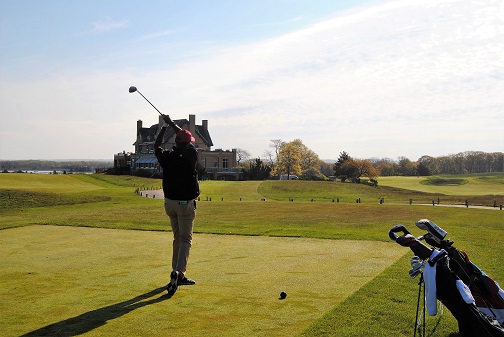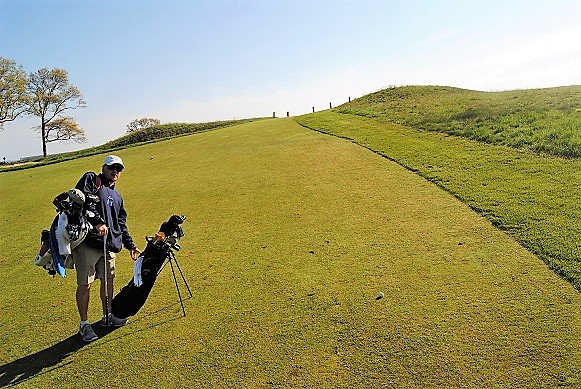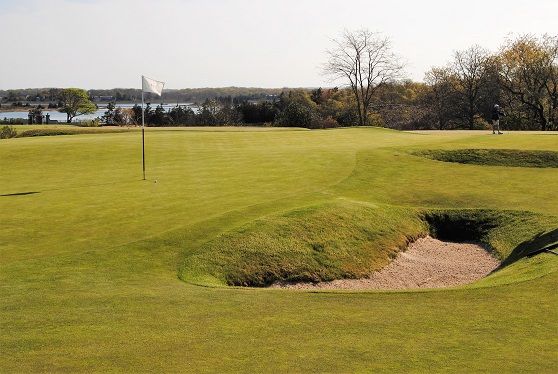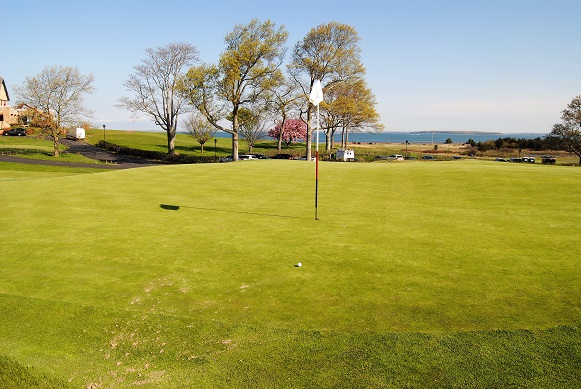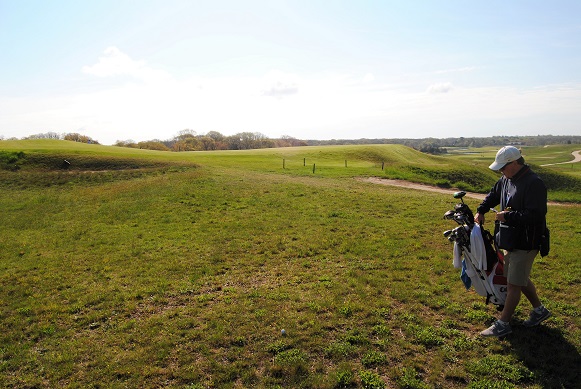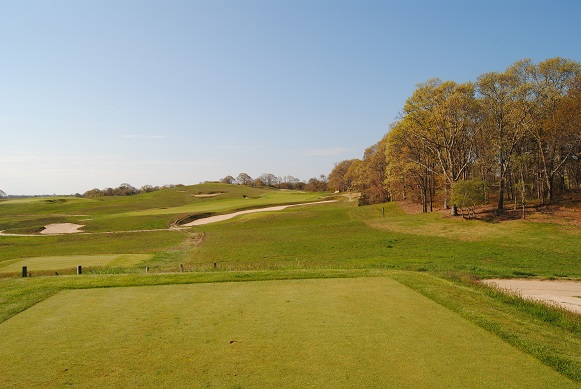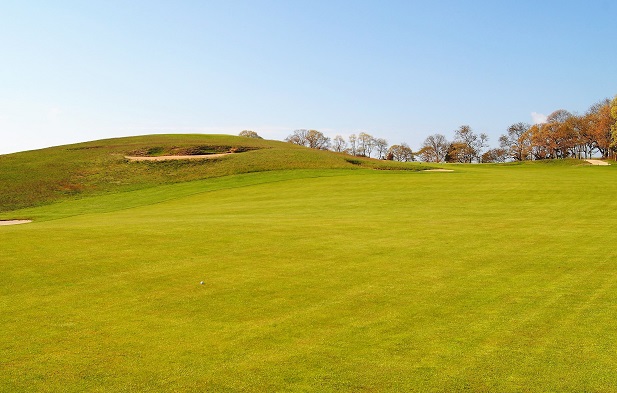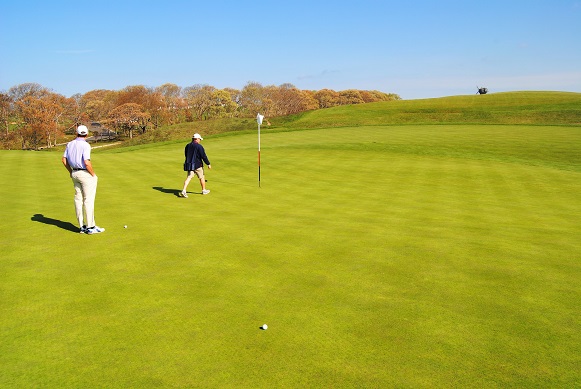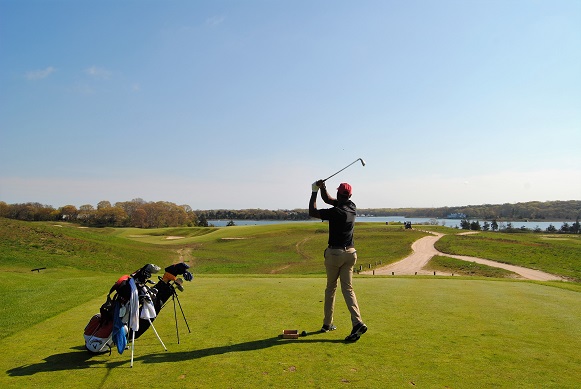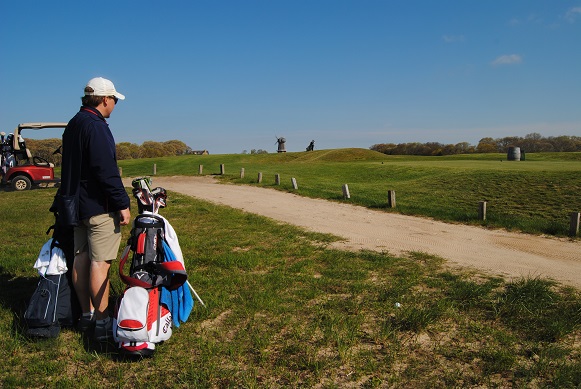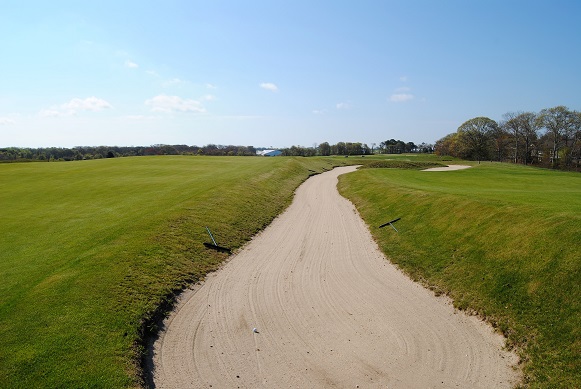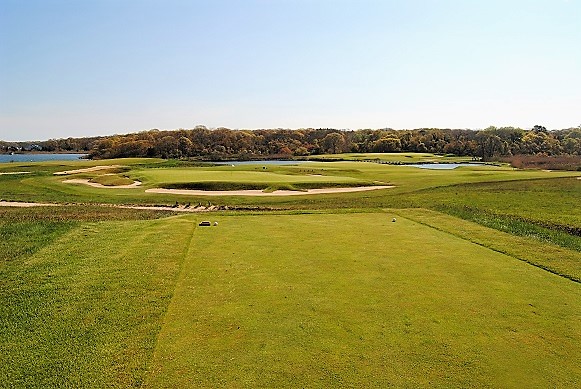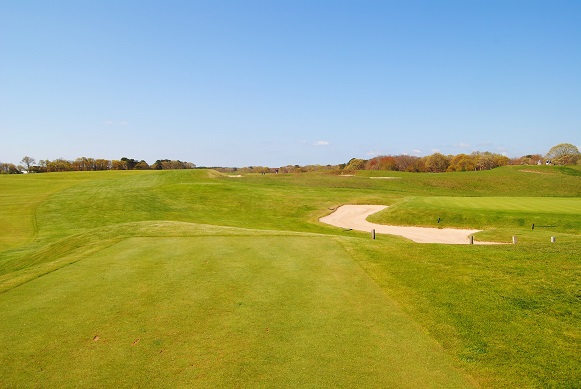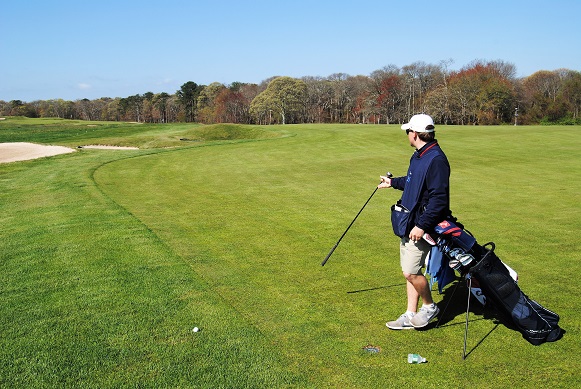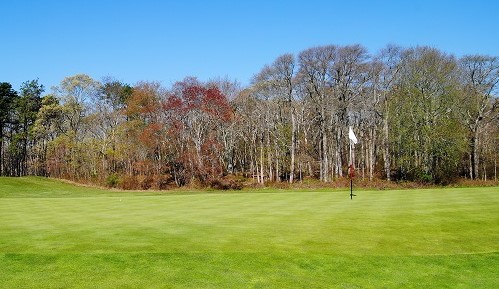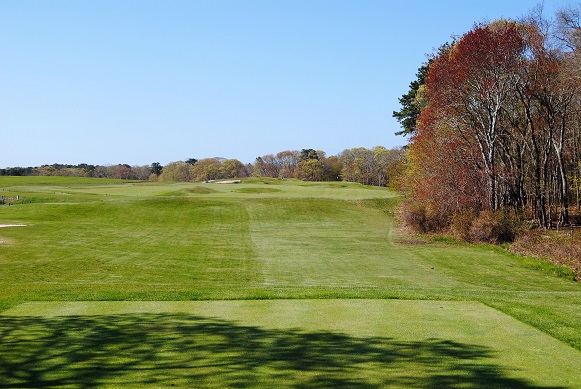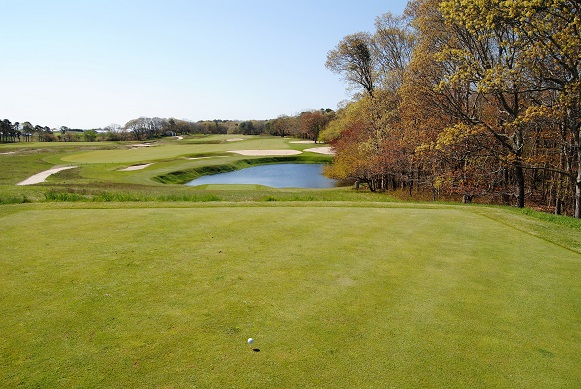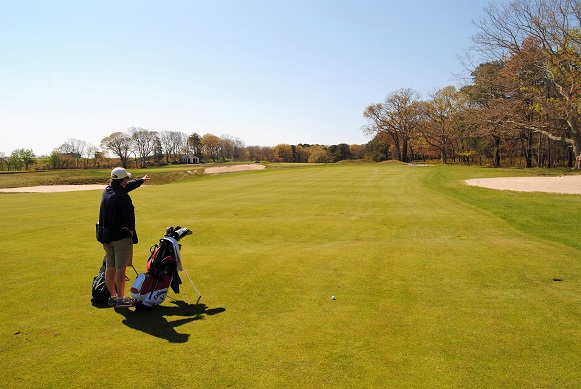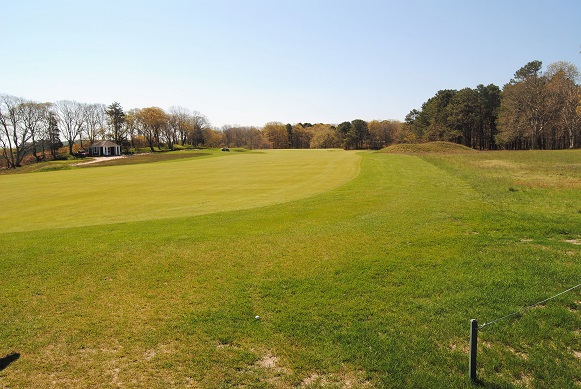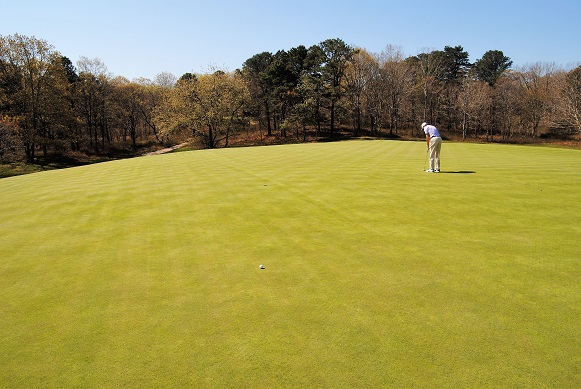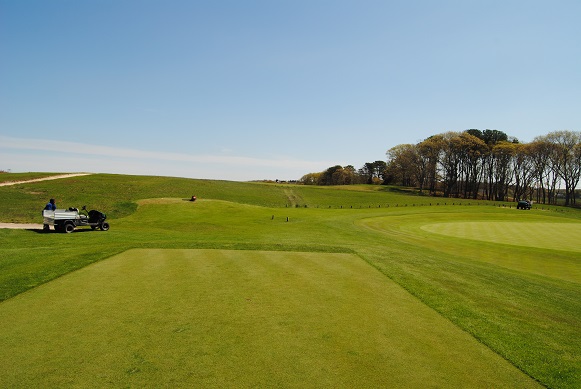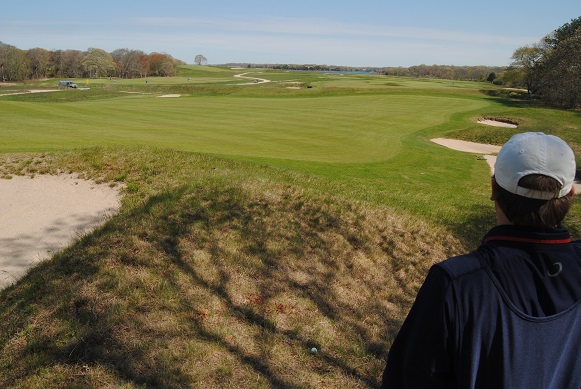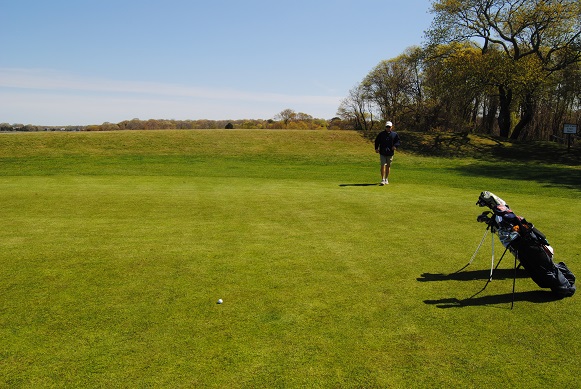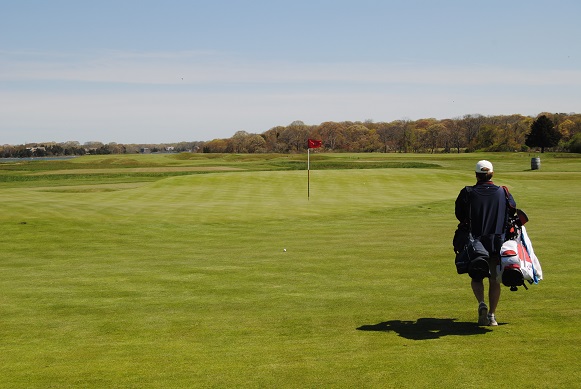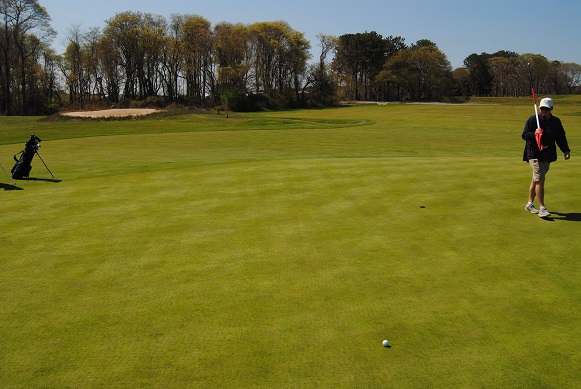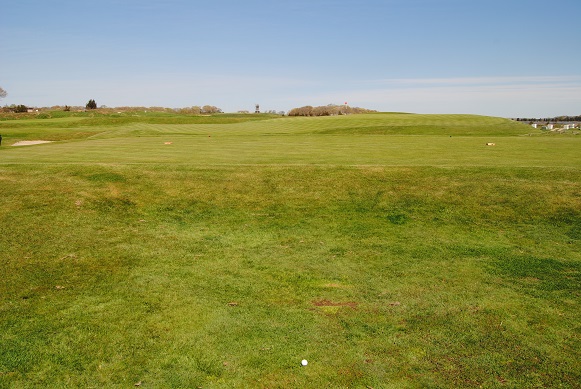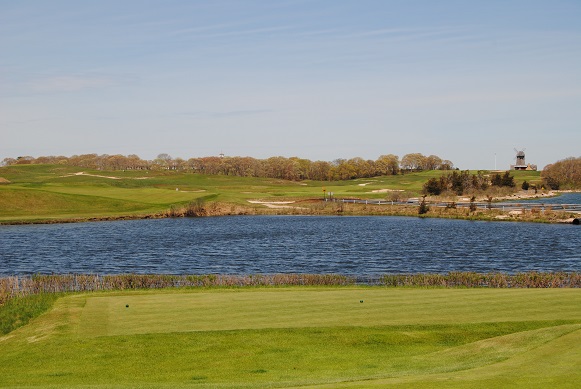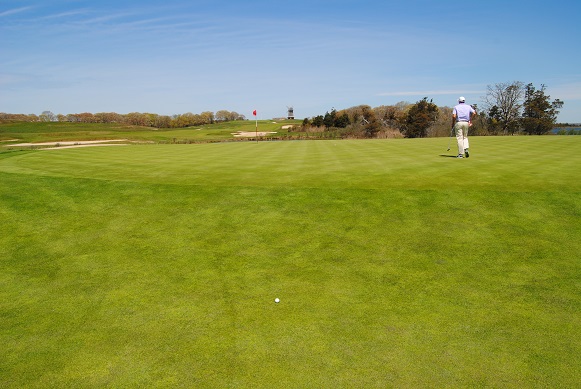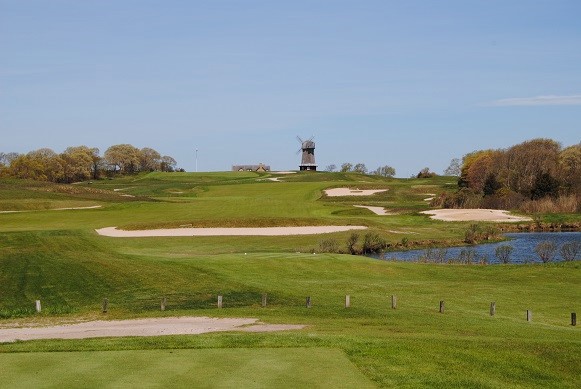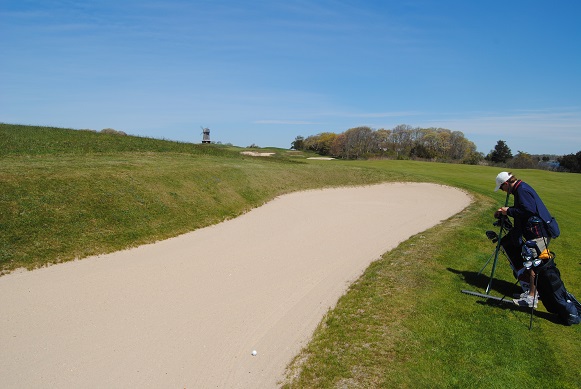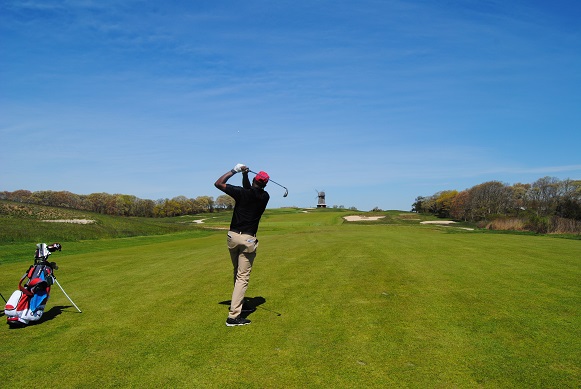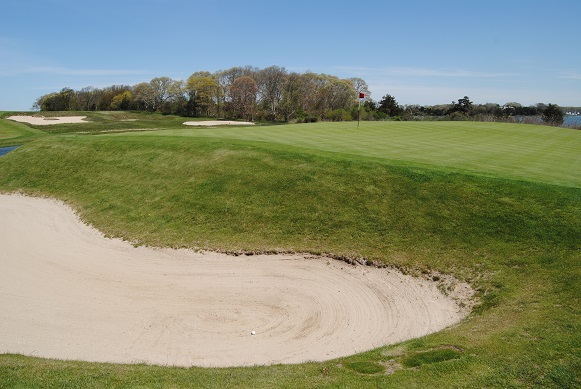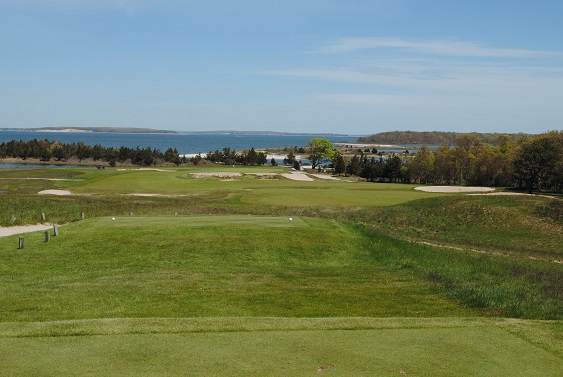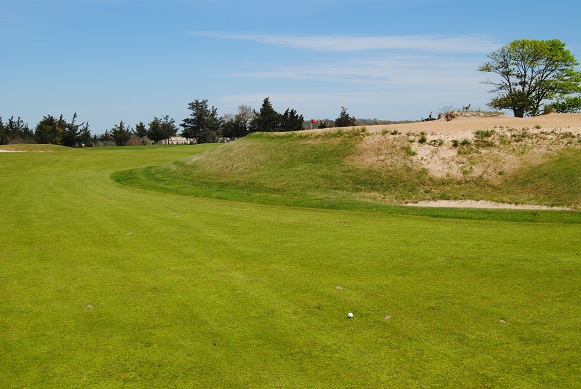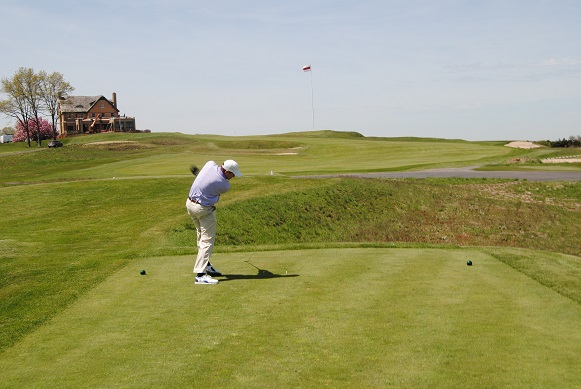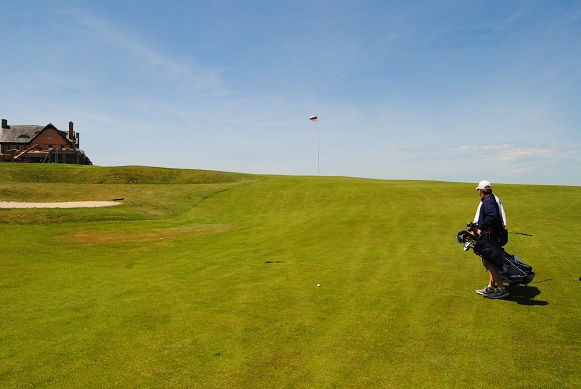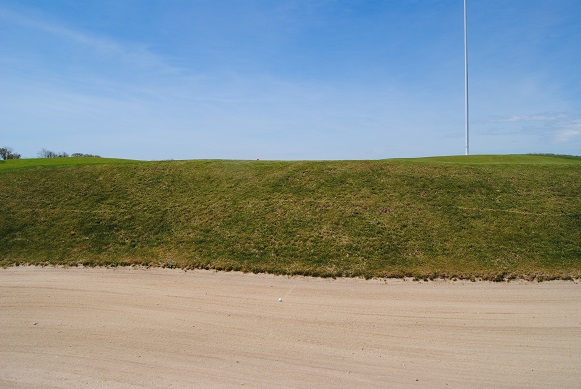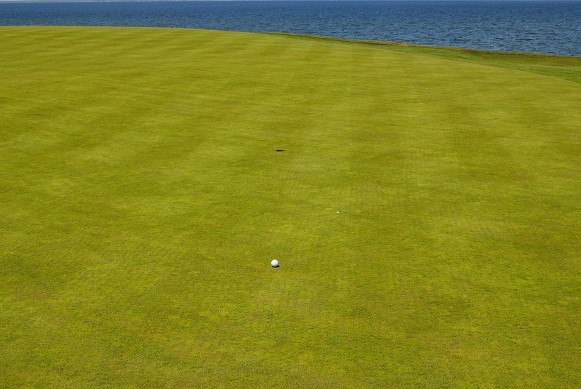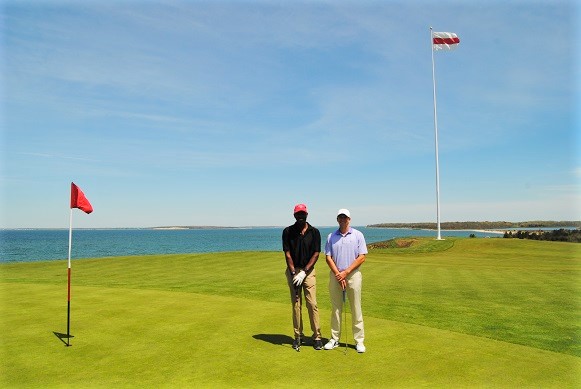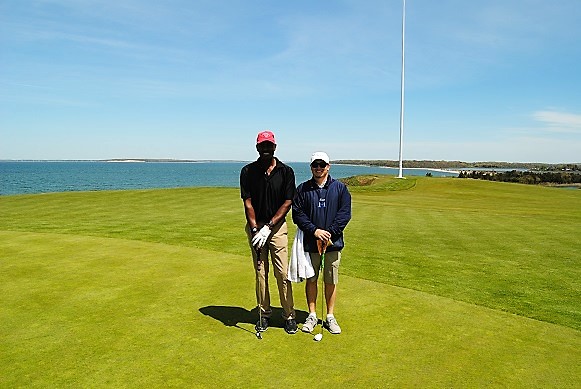The intense week of golf in my drive to complete the final courses in my one year quest to play all 100 courses in the Golf Digest 2017-18 Top Course in America, reached its peak on Friday, May 11th. I was scheduled to play both National Golf Links and Maidstone on the same day. I awoke early for the drive from my hotel in Riverbend, NY to Southampton where I was scheduled to tee off at 8:00 at National Golf Links. My round at National Golf Links had been arranged by a friend who had hosted me at a couple of other courses. He asked friend of his who is a member to sponsor me as an unaccompanied guest.
I had made the drive from my hotel to Southampton a couple of days earlier when I played at Sebonack. On that morning I left my hotel at 9:30 for what was a 20-minute drive. I mistakenly thought my drive at 7:00 a.m. would take the same amount of time. After driving for almost 20 minutes, my GPS ETA jumped from 10 minutes more to 30 minutes more. I called George, who controls the tee times at National Golf Links to inform him that I was stuck in some very heavy traffic that was barely moving. I told him that perhaps had been an accident ahead of me. He said, no, you are stuck behind the” trade parade.”
The “Trade Parade” is the early morning trek of the workers of the various trades pouring into Southampton to perform services for the residents. I should have anticipated this. We have a similar, but not as intense, “trade parade” on Kiawah Island each week day morning. George told me not to worry, that they would accommodate me when I got there.
The route to National Golf Links turned more torturous, not so much for the “trade parade”, but rather for the fact that it took me right through Shinnecock Hills. I drove within a few yards of the iconic clubhouse on Tuckahoe Road. Tuckahoe Road took me right between the 13th and 18th greens and across the 14th fairway. It was pure torture. I was so close I could taste it, but I couldn’t play it. On my final day in the Hamptons, I was still without a confirmed tee time at Shinnecock Hills.
I so wanted to stop and beg for the opportunity to play the course before it closed to guest in just a few weeks. I resisted that temptation. There were several people working on finding a member who still had playing privileges and could host me. My previous host had to regrettably cancel a week before our round due to a death in the family. While I was concerned, I still had faith that it would somehow work out. I was on a mission and was confident that I would meet my commitment of playing all 100 courses before June 12th. I exited Shinnecock Hills and continued to National Golf Links.
Once I arrived at National, I parked and tried to figure out where to enter the clubhouse. A guy looking out of a window that overlooked the parking lot, directed me to the men’s locker room. It still took a little figuring out, but I got there and met Steve. Steve was friendly, welcoming, and knowledgeable. He set me up in a locker, told me about the club and the course, and directed me to where I could find George. He also cleaned and dried my golf shoes for me.
I checked in with George and then headed to the pro shop where I met Tim who was working behind the desk and Elliot, the assistant pro who was assigned to play with me. I also had an opportunity to speak briefly with James Morris the Head Professional at National Golf Links.
Since I had arrived late due to the “trade parade”, Elliot and I headed straight to the first tee with our caddie, Evan. We chose to play from the regular tees which measure 6505 yards with a course rating of 71.9 and a slope of 136. National Golf Links which was founded back in 1909 is one of the oldest courses that I played during my one-year quest to play the Golf Digest 2017-18 Top 100 Courses in America. It has holes that pay tribute to some of the most iconic holes in the UK and Ireland. A
The first hole is a short par four which measures 315 yards. The tee box is elevated and off set to the left of the fairway. There is a 185 yard carry over rough to reach the start of the fairway which doglegs slightly to the left before bending back to the right as it approaches the green. There are three cross bunkers and one other small bunker in the rough just short of the fairway. There are three more bunkers to the left of the fairway starting at about 200 yards out and continuing to 250 yards from the tee. The trouble to the left of the fairway was no concern to me. My concern was the rather large bunker in the right side of the fairway at about 265 yards from the tee.
I chose a three wood off the tee to stay short of the bunker in the right side of the fairway. My tee shot landed in the fairway just off the right edge leaving a 75 yard uphill shot to a front right pin on a green with two bunkers along the right side.
I hit a lob wedge along a line too far to the right. The ball landed pin high in the first bunker along the right side of the green. Elliott stiffed his approach shot to less than a foot from the flag.
My sand shot stopped seven feet short of the hole.
I made the putt to open my round with a par.
The second hole is an even shorter par four, measuring a mere 290 yards. The tee box is almost perpendicular to the left side of the fairway. It is in line with the iconic windmill that symbolizes National Golf Links. There are bunkers along the side of the tee boxes. There is a 200 yard carry over the rough and a massive bunker with islands of rough to reach the fairway across the left side. The fairway has rough cutting into it from the right side at about 240 yards from the tee creating a narrow neck at about 50 yards from the middle of the green. I hit my three wood off the tee again on a line just to the right of the bunker on the left side of the green. My ball rolled through the fairway into the left rough leaving 60 yards to the green and a left pin. I had picked a bad time to hit a 260 yard three wood.
I hit a pitch shot to 35 feet right of the flag. My putt got a way from me and ran 10 feet past the hole. I missed the comeback putt and tapped in for a three-putt bogey.
After the two short opening holes, a real golf hole showed up for the third hole. It measures 407 yards and is the number one handicap hole on the course. The fairway is broken up into 3 sections. The first section is an island in the rough at about 140 yards from the tee. It continues just 40 yards before ending at a cross bunker that separates it from the second section of the fairway. The second section of the fairway starts at about 185 yards off the tee and is initially about 60 yards across with two bunkers off the left side. At about 260 yards out it narrows to about half that with trees tight along the right and a bunker and rough along the left side. There is also a bunker that cuts in from the right to make the fairway ridiculously narrow for a few yards, but that is so far from the tee that it’s not in play. This section of the fairway ends at rough about 75 yards from the middle of the green.
The third and final section of the fairway is another island to the left of the last portion of the second section. It starts at about 85 yards from the middle of the green and is separated from the green by a cross bunker and an apron just short of the green.
I hit my driver for the first time during the round and landed the ball in the left fairway, leaving 185 over rough and the third section of the fairway to an uphill green which was playing like it was 210 yards.
I hit my approach shot fat. The ball landed 50 yards from the left middle pin. I pitched on to thirty feet pass the hole.
I was left with a very fast putt, but Evan provided an excellent read. I drained the putt for a par. This took a little of the sting off the three-putt bogey on the previous hole.
The first par three on the course is a Redan hole. Redan holes are par threes with greens that are usually at a 45-degree angle that slope severely from right to left toward a bunker off the left side of the green. This specific Redan hole also has a bunker at 140 yards from the tee. There is rough between the tee and the bunker. There is a shaved area short of the green and bunkers to the right. The hole measures 181 yards.
The foursome ahead of Elliott and I motioned for us to play through. Have I ever mentioned that playing through on a par three is one of the hardest shots in golf? You get nervous with the group ahead watching you hit your tee shot. I hit my tee shot way right and across a cart path into the rough. Golf can really make you look silly sometimes.
I recovered nicely, however with a pitch shot that left 25 feet to the cup.
My par putt slide just right of the hole. I tapped in for a welcomed bogey and headed toward the fifth hole. It's bogey saves like this that allow you to keep your round intact.
The fifth hole is the second most difficult hole on the front nine and the third most difficult hole on the course. It is a long par four which measures 451 yards. It has the customary rough and bunkers that separate the tee box from the fairway. The fairway is extremely wide for the first 250 yards. It then splits into a left side and right side with a strip of sand separating the two sides. The right side ends after about 50 more yards. The left side continues to the green and is extremely narrow at first but gets increasingly wider the closer it gets to the green. I hit my drive 260 yards to that narrow strip of sand that separates the two side of the fairway.
I was left with 200 yards to the flag, but I had two fortunate things going for me. First, the wind was helping. Secondly, the bunker was shallow. I hit a five iron from 200 yards that flew the green and landed in the rough off the back.
I pitched back onto the green to eight feet short of the hole. Unfortunately, I missed the putt and made a bogey on the hole. I was that close to making par on the two most difficult holes on the front nine. Lost in all of this is that I had not yet come close to double bogey territory.
The sixth hole is one of the most beautiful holes on the course. There is a view of a bay and a lake with trees in the distance. The hole is called Short. It is the shortest hole on the course. It’s a 123 yard par three that is all carry over rough and a bunker to the green. The green is incredibly wide. It measures almost 60 yards across and has a depth of 35 yards. There are seven bunkers that surround the green, but with the size of the green, there is no excuse for missing the green and worrying about the bunkers.
The pin was in the dead center of the green in between an upper tier and a lower tier. I hit my tee shot on a line to the left of the flag expecting the wind off the bay to push the ball to the right. It didn’t. My ball landed 40 feet to the left of the flag.
Elliot helped me with the read and gave me an excellent line. The ball was tracking toward the hole but stopped one foot short. I tapped in for my third par in six holes.
The seventh hole is the first par five on the course. It is a par five that is less that twenty yards longer that the par four fifth hole. This time the tee box is offset to the right of the fairway and points toward a bunker laden area of rough off the right side of the fairway. There is a 200 yard carry across that area to reach the right side of the fairway. The left side of the fairway bulges out to provide a generous landing area but leaves a longer shot that makes it impossible to right the green in two. Besides, there are also several bunkers around that landing area. This hole offers some risk/reward opportunities. It is Elliott’s favorite hole.
I was swinging the club well, so I decided to take on the bunker laden rough. I hit a great tee shot that easily carried the rough. The ball rolled through the left side of the fairway stopping just in the rough and just short of a series of three bunkers that cut into the left side of the fairway. I was left with 220 yards to the green for my second shot.
I left my second shot short of the green. I then pitched on to 25 feet past the flag.
I hit a good putt, that looked that it was going to drop for a birdie. For the second time during the round, I left the ball one foot short of the cup. It was an easy but disappointing par.
The tee box for the 385 yard par four eighth hole is pressed up against trees that form the western boundary of the course. There is a 200 yard carry over rough to a bifurcated fairway. The bifurcation is formed by a line of seven small bunkers. Both sides of the fairway are narrow, but the two sides join and provide a very generously wide fairway at about 260 yards from the tee.
There is rough and bunkers along off to the left and the right sides of the fairway, but that shouldn’t be an issue with 70 yards of width available to land the ball. There are also three bunkers clustered together at 300 yards off the tee, but that would never be an issue for me. Especially on this day on this hole. I hit a low drive that barely carried the rough. The ball landed in the right side of the fairway and rolled, leaving 225 yards to the pin.
The oval green is protected by bunkers across the front and off the left side. The right side of the green slopes down toward trees. There are also trees close off the back of the green. Evan advised that I lay up with a 7 iron and leave a nice pitch to the green. This would allow the ball to carry the cluster of bunkers in the middle of the fairway yet stop short of all the trouble around the green. It was sage advice. I hit my seven iron flush. The ball traveled 180 yards leaving just 45 yards to the green.
I pitched on to six feet and made the putt for par.
The 534 yard ninth hole takes you to the southern most point on the golf course and very close to Shinnecock Hills. I won’t get into that again. The tee box is offset to the right of the fairway. There is a 190 yard carry over rough, water and a couple of bunkers to reach the right side of the fairway. There are additional bunkers and trees close off the right side of the fairway and more bunkers and rough off the left side. The fairway is interrupted at 300 yards from the tee by rough and bunkers before picking up again 40 yards farther. I hit my drive down the middle of the fairway. The ball hit and rolled to the right side of the fairway leaving 310 yards to the green.
I caught my three wood thin on my second shot. The ball never got more that a few feet off the ground. It cleared the rough and the bunkers at the end of the fairway but hit the upslope where the fairway picks back up. The ball then kicked right and rolled just into the rough.
I was left with 195 yards to a back right pin, but Evan assured me that all I needed was a six iron to reach the green. I trusted him and hit the ball to 15 feet below the hole.
I missed my birdie putt but made the next putt for a par to finish the front nine with a double bogey free 40. We walked off the green to make the turn back to the clubhouse. There is a halfway house at the turn. We stopped for drinks and snacks and before continuing to the 10th tee.
The 10th hole is called Shinnecock. I might be it’s because it borders Shinnecock Hills. So, there I was again being tormented by the fact that I was yet to confirm a tee time there. The tenth hole is a 420 yard par four with a very wide fairway for the first 330 yards. The fairway ends at that point at cross bunkers. It picks up as a much narrower fairway just past those bunkers at just 100 yards from the middle of the green.
There are bunkers and trees to the right of that last 100 yards and bunkers and rough to the left. I hit a 210 yard drive to the middle of the fairway.
The remaining 210 yards was playing like 250 yards into a strong wind. Evan and I discussed the hole, I misunderstood his answer to a question on how much rough there was between the end of the left side of the fairway and where the fairway picks back up following the cross bunkers. At 250 yards out and a strong wind in my face, I thought it would be an excellent opportunity for a low shot with my driver off the deck.
I hit the ball a little lower than I wanted, it never got more than a few feet off the ground. The ball carried the cross bunker on the left side of the fairway and landed in the rough. It stopped cold after hitting the rough. It was only after I got close to the end of the fairway that I realized that the continuation of the fairway was so narrow. My ball was in the rough, 90 yards from the middle of the green.
There were two bunkers including one just off the front left side of the green, between my ball and the flag. There were additional bunkers off the left side of the green. I compounded my error from the second shot by popping my ball up on my third shot. The ball landed in the bunker just short of the green.
I hit my bunker shot to the green and two putted for my first double bogey of the round. That let the air out of my sails. After shouting a 40 on the front nine, I thought I was on pace to break 80.
One of the interesting features of National Golf Links is that the tee boxes are usually snuggled up against the green from the previous hole. The walk from the green to the tee is short. It doesn’t leave much time to allow the previous hole to linger. Additionally, holes five through twelve are a tough stretch of golf. I think those eight holes form the heart of the course and I almost made it through them without a double bogey.
The eleventh hole is a 418 yard par four with a wide but noncontinuous fairway. The carry to the beginning of the fairway is one of the shortest on the course. The fairway is uphill from the tee box and starts with a knob on the left front and a bunker to the right of that knob. It then widens to about 80 yards with a couple of bunkers off the left side and several between the right edge and the trees that line it.
The fairway is bisected at 150 yards from the green by a road. It picks up on the other side of the road with 110 yards left to the middle of the green. There are bunkers off both sides of that remaining stretch of fairway. I hit my drive down the right side of the fairway. The wind pushed the ball farther right. It landed right in the middle of a patch of wild grass (weeds) just over the first bunker off the right side of the fairway.
I was left with 255 yards to the green but that wasn’t the worst of my problems. My biggest issue was the lie. The ball was below my feet and in a cupcake holder made of weeds. I advanced the ball just 90 yards to the middle of the fairway. I was left with a blind shot to the green. Evan gave me a good line on the flag. I hit my third shot straight along that line. My ball landed just short of the green.
I two putted from there for a bogey.
The twelfth hole is the most difficult hole on the back nine. It’s the last of the holes that I consider the heart of the course. It measures 427 yards to a deceivingly narrow fairway. I say deceivingly because it connects to the seventh fairway off its left side. There are bunkers in the narrow strip of rough just between the two fairways just before they join. There are bunkers and trees tight along the right side of the fairway. One of the bunkers is exceedingly long. It runs from 140 yards short of the green to 70 yards short of the green.
The wind was now blowing 15 to 20 miles per hour, making a tough hole even tougher. I hit my drive to what was either the right side of the seventh fairway or the far-left side of the 12th fairway. It was the portion of the fairway to the left of the strip of rough with the bunkers in it. It seemed more like the seventh fairway. In either case I was left with 210 yards to the green.
The 210 yards were playing more like 230 yards. I hit a solid three wood that landed right and 60 yards short of the green. The good news was that it carried the long bunker off the right side of the fairway.
My third shot landed on the green but rolled off. I chipped to six feet short of the hole and made the putt for my second straight bogey on the back nine.
The thirteenth hole was an unlucky hole for me. It is the Eden Hole and the only par three on the back nine. Eden holes like Redan holes have a specific design. They are par threes with a green that usually slopes back to front and is well protected by bunkers. This one measures 159 yards with a water carry, a bunker that starts on the right front of the green and wraps around like a “J” to the left edge of the back of the green. There are also three additional bunkers in front of the right half of the green and one along the left side of the green.
I recorded a double bogey on the hole after hitting my tee shot into the trees off the right side of the green. My second shot landed on the left side of the green and rolled into the bunker. My sand shot barely made the green. I two putted for my second double bogey on the back nine. That beautiful round that started on the front nine was now fading away.
While my golf swing was getting worse and the holes were about the get easier, the views on the course were getting even better. The view from the tee box on the short par four fourteenth hole is one of the nicest views on the course. There is water in front of the tee box and to the right along with a clear line of sight to the iconic windmill. The hole measures 341 yards. The tee box is offset to the right. There is a 170 carry across the water to the right side of the fairway. A shot hit through the fairway could put you in one of the four bunkers off the left side. There are also two large bunkers along the right side of the fairway in the landing zone. I hit a three wood to the right side of the fairway leaving 160 yards to the green.
The strong head wind meant the shot was playing more like 190 yards. From my position on in the fairway I had to carry the left side of a pond that was off the right side of the fairway and along the right side of the green. The pin was positioned on the left side of the green about 35 yards away from the water off its right side. There are bunkers on the left just short of the green and a bunker that wraps around the back half of the green. I hit a five hybrid right at the flag. The ball was struck pure and held its line. The wind was just too strong for the ball to reach the green. It fell just short.
I putted from just off the front of the green. I put a little too much juice in the putt. The ball rolled 10 feet past the hole. I missed the comeback putt and continued my string of non-par holes on the back nine.
The 368 yard par four fifteenth hole is called Narrows and for good reason. It has a fairway that is barely 30 yards wide with bunkers and deep rough all along the edges. There is a lot more area on the hole that is taken up by rough and bunkers than there is fairway. Mr. Macdonald must have realized that he had a lot of sand left and not many holes to use it, so he dispensed of much of it on this hole. I counted at least 11 bunkers from the tee box. I hit my drive on a line toward the second bunker off the left side of the fairway expecting the ball to fade. It didn’t. The ball landed short of the bunker and rolled it leaving 163 yards to an uphill green with a whole lot of bunkers protecting it.
As well as I had hit my five hybrid on the previous hole, it wasn’t enough to get to the green. I thought I was far enough from the front of the bunker to hit my three hybrid. Unfortunately, I caught the ball a little high. It came out low and hit the lip on the front of the bunker. The ball landed in the middle of the fairway about 125 yards from the green.
I pulled the ball on my third shot. The ball landed in the bunker that ran along the left side of the green.
I hit my sand shot to within three feet of the cup. I made the putt to save bogey. At this point I was starting to get a little frustrated at my inability to make a good swing. Something in my swing had changed after my driver off the deck shot on the 10th hole. But for the life of me I couldn’t figure out what I was doing differently. This stuck in my mind as we moved on to the 16th hole.
The 16th hole is a C.B. Macdonald design classic. It’s the Punchbowl hole. The punchbowl hole is marked by blind approach shot to a green that is at the bottom of a bowl with all the slides sloping down toward it. The hole is a par four that measures 394 yards. There is water off to the right of the tee box. The tee box is aligned with the middle of the fairway, but the fairway makes a shift from left to right at about 200 yards off the tee. There is a small bunker in the left rough at 210 yards from the tee and a large one across the fairway in the right rough. I hit my drive into the bunker on the left.
The ball came to rest close to the upslope at the front of the bunker. With over 200 yards remaining to the middle of the green, my priority was to just get the ball over the face of the bunker. I hit a 9 iron to 125 yards.
My third shot landed in a patch of rough short and right of the green. I pitched into the onto the green and two putted for my third double bogey. By now my frustration had reached its peak. While there were no outward expressions, I was steaming on the inside. I felt like I’d ruined what could have been a very good round. When I play with assistance pros I don’t usually ask them for advice on my swing. I want them to enjoy the round and not be burdened by my swing flaws. But with only two holes remaining and no pars thus far on the back nine, I needed help to salvage my round. I asked Elliott if he had noticed what had changed in my swing. He said “yeah, you’re getting in front of the ball. You need to stay back.” That gem of wisdom on my swing flaw made a world of a difference.
I approached the 342 yard par four 17th hole with a new swing thought – stay behind the ball. The hole plays downhill to a fairway and a green with the Great Peconic Bay as the backdrop. C.B. Macdonald again worked on using up those final loads of sand. The hole has too many bunkers to count. They are large and small. There are along the fairway and in the fairway. And they are like flies on stink around the green. The fairway is offset to the right of the tee box. It meanders through, around and over bunkers. It narrows significantly as it approaches the green.
With my new swing thought fixed in my mind, I swung my three wood and made great contact with the ball. The ball went straight. I just hit it on the wrong line. It landed in one of the bunkers off the left side of the fairway.
I caught a little too much sand on my shot out of the bunker. The ball landed on the right side of the fairway short of a mound that blocked my view to the green. While I couldn’t see the green, I could see the flag which was just 80 yards away.
I hit my lob wedge to 10 feet right of the flag. I drained to putt to finally make a par on the back nine.
I approached the eighteenth tee box with that singular swing thought about hanging back still fresh in my mine. The closing hole at National Golf Links is the only par five on the back nine. It’s a short measuring just 483 yards. Old C.B. must have been successful at depleting the sand on the previous holes. While the 18th hole has several bunkers, yard for yard, there are fewer than on the preceding holes.
Elliot hits his drive on the 18th hole.
The tee box and the fairway are aligned, but there are also a couple of bunkers at 190 and 220 yards out that are aligned with it too. The fairway curves around those bunkers. There are two bunkers off the right side of the fairway to the right of the curve. I hit my drive down the left side of the fairway.
The rest of the hole is uphill and blind from the position where was my ball lay. To avoid the mistake of hitting a good shot to the wrong place, I took out my yardage book to see what lay between me and the hole. The contour and lay out of the remaining fairway made it a treacherous second shot. There were several bunkers in play. Evan directed me to hit the ball right at the flag pole. He said I needed a 180 yard shot to clear the bunkers that were cut into the right side of the fairway. I made solid contact with my three hybrid. The ball took off on a straight line toward the flagpole. I just wasn’t sure I’d hit it hard enough to carry the bunker on an uphill shot. As we approached the final bunker, we could see that the ball had hit on top and bounce back into the bunker. It looked like another yard or two would have carried it.
I was 125 yards from a front left pin position. The green was uphill but free of bunkers around the front and the left side. I thought I could get my pitching wedge over the face of the bunker and reach the green. I so badly wanted a par to close out my round. I was almost right, but this wasn’t hand grenades nor horseshoes. The ball caught the top of the bunker, kicked straight up and landed in the fairway, 115 yards from the pin.
I still wanted to make that par. I told both Evan and Elliott that I was confident that I could landed the ball close. A 115 yards uphill shot to a left pin was a perfect opportunity for my sand wedge. I just needed to remember Elliott’s tip on staying behind the ball. I kept that single thought in the front of my mind as I swung the club. I hit the ball high. I wanted it to stop and not release. The ball landed just 10 feet left of the hole.
I took my time on the putt. Evan told me to hit a firm putt inside left. I focused, took a deep breath, exhaled and stroked the ball. It dropped to the bottom of the cup. Mission accomplished! I closed with two pars to offset two of the three double bogeys I made on the back nine to finish with a 46 and a combined score of 86. It was a disappointing 86 given my front nine performance, but at least I finished strong.
I enjoyed playing with Elliot and making the loop with Evan on my bag. His excellent reads took several strokes off my score. Following my round, I headed back to the locker room to clean up. I reconnected with Steve and met Steve number two who had just come on shift. We talked about the course and the rest of my quest. I told them that I was going to grab some lunch and head to East Hampton to play at Maidstone at 3:00. Steve number one asked who I was playing with. I told him that Sergio was hosting me. He told me that Sergio was also a member and National and that I would really enjoy playing with him. He said Sergio was a great guy. Now this is Sergio from Colombia not Sergio from Spain!
Steve also told me that I could have lunch in the dining room. He said that coats were usually required but since the birdcage was under repair due to an electrical fire on the roof, they were waiving the coat requirement. The birdcage is a room at the front of the clubhouse where members and guests can eat without the need for a jacket. I took Steve’s recommendation and dined on site before making the drive to East Hampton.
I’d like to thank my friend for arranging for a buddy of his to set up my round at National Golf Links. The course is truly an Ode to Golf!



